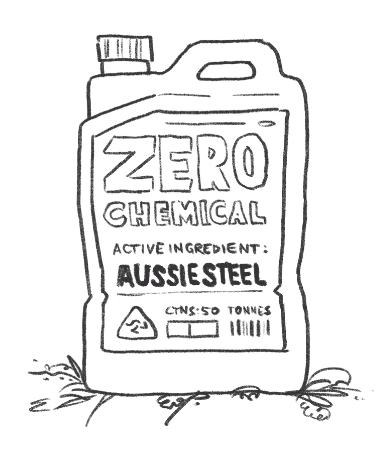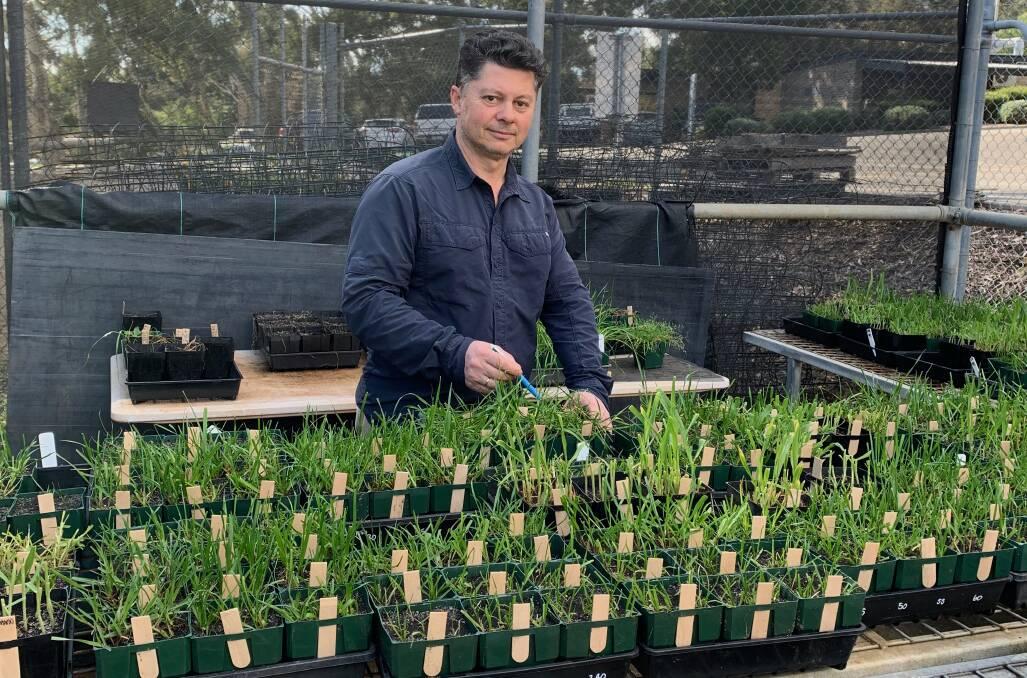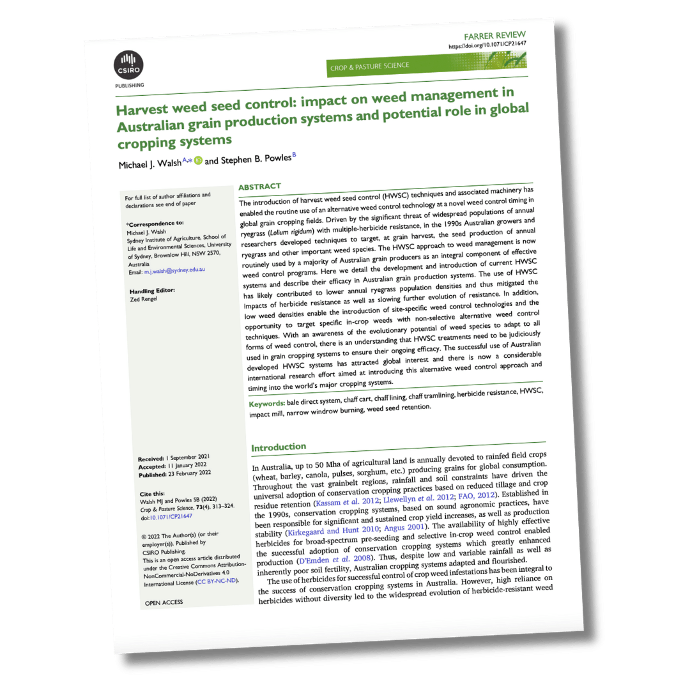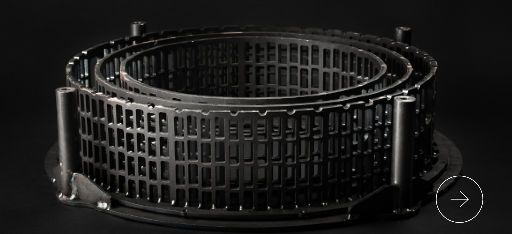HARVEST WEED SEED CONTROL
01
Reducing the cost of chemical
Terminating weeds at harvest takes the pressure off alternative strategies, eliminating a burden of jobs and expenses from your practice. A streamlined harvest means more productivity and less collateral damage caused in-crop.
02
Opening up more flexible farming
With fallow land free from weeds and volunteers, moisture is kept in the ground so you can take advantage of early sowing and increase your yields. Less chemical residue also unlocks your options to plant what you want each season.
03
Tackling weed burdens for good
Mechanical control is a final solution, interrupting the weed cycle so less and less weeds return each year. Covering your chemistry safeguards against the development of herbicide resistance and guarantees the return on your investment.
At harvest time, many weeds in the crop retain their seeds, making it a crucial period for weed seed control.
HWSC Techniques and Applications
- A variety of HWSC techniques exist, such as chaff carts, baling crop residues, chaff lining, chaff decks, narrow-windrow burning, and weed mills.
- HWSC is adaptable to different farming systems, crop types, and locations, with tactics like bale, burn, graze, mill, or rot.
Factors Influencing HWSC
- The effectiveness of HWSC depends on various factors, including the season, weed phenology, crop growth, and weed competition.
- Specific attention to harvester setup is required for capturing weed seeds in the chaff fraction when using techniques like chaff lining, chaff decks or Mills like the Seed Terminator.
- Some methods of HWSC are more effective than others
Regional Considerations
- The effectiveness of HWSC methods can vary based on regional factors such as crop types, harvest conditions and climate.
The WeedSmart Learning Hub has short courses here
Herbicide resistance is when weeds develop the ability to survive herbicide treatments that once controlled them.
A Global Challenge
- Herbicide resistance is a widespread issue, with 530 unique cases involving 272 species globally. Weeds have adapted to 21 of 31 herbicide action sites and 168 herbicides. This problem affects 100 crops in 72 countries, highlighting the need for innovative solutions.
- Resistance reduces the effectiveness of herbicides leading to reductions in crop yield, complicates weed management, and increases farming costs.
Go to the Global Herbicide Resistance Database
Causes of Herbicide Resistance
- Over-reliance on a single herbicide or herbicide class leads to resistance. Genetic mutations in weeds play a key role.
- Target-Site Resistance: Occurs when mutations in the weed's target protein reduce the herbicide's effectiveness. Specific to the site of action of the herbicide within the plant.
- Metabolic Resistance: Weeds metabolically detoxify or degrade the herbicide before it can act. Non-specific and can provide cross-resistance to different herbicides.
Current Management Strategies
- Rotating herbicides, integrating non-chemical methods, and using multiple herbicide modes of action help manage resistance.
Prevention and Monitoring
- Regular monitoring of weed populations (Resistance Testing) and preventive strategies are crucial to delay resistance development.
We are working on a calculator specifically for Seed Terminator, if you would like to be a part of the pilot study, please contact us on enquiries@seedterminator.com.au to find out more.
In the meantime check out the WeedSmart Cost Calculator created by Peter Newman, Western Extension Agronomist here
Managing Chaff Only
Chaff Carts: Attached to the rear of a combine harvester, chaff carts collect chaff containing weed seeds. This chaff can be stockpiled for later use as livestock feed, burned, or processed in other ways to manage weed seeds. This method suits farms that integrate crop and livestock production since the chaff serves as feed, though it might reintroduce seeds via manure.
Chaff Lining: This method directs chaff into narrow rows left on the field over winter, exposing weed seeds to natural degradation and predation. This approach might still require herbicidal intervention and is often seen as a preliminary method for managing weed seeds.
Chaff Decks (Tramlining): Similar to chaff lining but specifically targets the combine’s wheel tracks for depositing chaff. The subsequent compaction from traffic helps suppress weed growth, fitting well into controlled traffic farming systems.
Mills: Considered one of the most effective HWSC methods, impact mills crush the chaff, destroying the weed seeds within before distributing the remnants back onto the field.
Managing Chaff + Straw
Bale Direct: This system captures all crop residues—both chaff and straw—directly from the combine and compresses them into large bales. These bales can be sold, providing an additional revenue stream.
Narrow Windrow Burning: Collects all crop residues and arranges them in narrow windrows for burning. This method effectively destroys weed seeds but also removes organic matter from the field, which could have implications for soil health.
These methods provide various options for farmers to manage weed seeds and crop residues efficiently, each with its own set of benefits and challenges, including capital and ownership costs, nutrient removal costs, operational costs, and labor costs.
Making the most of every pass
"It seems crazy that we spend time and money killing weeds all year, only to reward the survivors at harvest and spread them out so we have something to spray next year."
- Peter Newman, Western Extension Agronomist
February 2022
Harvest weed seed control: impact on weed management in Australian grain production systems and potential role in global cropping systems
The successful use of Australian
developed HWSC systems has attracted global interest and there is now a considerable
international research effort aimed at introducing this alternative weed control approach and
timing into the world’s major cropping systems.
Michael J. Walsh, and Stephen B. Powles
Read publication
Completing the Toolkit
Reliable weed control doesn't have to come in a drum
Would you buy it if it came in a drum at $15 - $30/hectare?

Since 2020 we have collaborated with Plant Science Consulting to provide free Quick-Test Herbicide Resistance Testing to agronomists in Australia.
Developed in the late 1990s by Dr. Peter Boutsalis, the Quick-Test is an essential tool for managing herbicide resistance offering resistance results after just four weeks. Dr. Boutsalis, is a seasoned agricultural consultant and researcher with The University of Adelaide Weed Science Research Group. Knowing a weeds’ resistance profile helps agronomists and farmers devise targeted management strategies to protect their crops. To find our more about our program, fill in the form above.

Where to from here?



